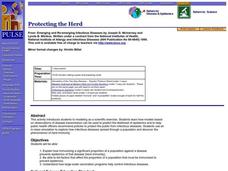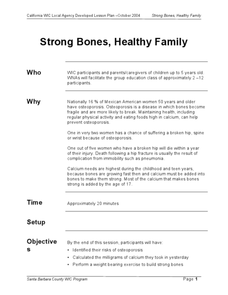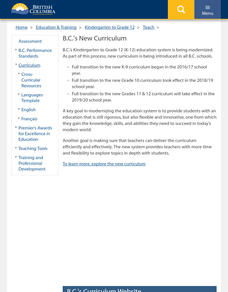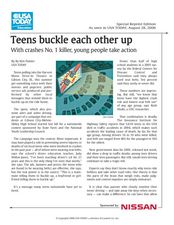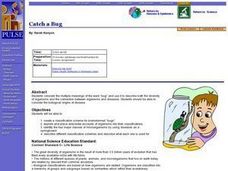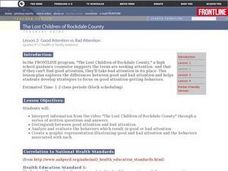Curated OER
Heart Healthy
Students assess their risk of heart disease. In this adult health lesson, students differentiate saturated and unsaturated fats. They discuss different heart healthy food ideas.
Curated OER
Epidemiology 1: What's My Hypothesis?
Students demonstrate how descriptive epidemiological clues can be used to make educated guesses as to what might be the cause of a disease. They utilize handouts imbedded in this lesson plan.
Curated OER
Protecting the Herd
Students explain how immunizing a significant proportion of a population against a disease prevents epidemics of the disease (herd immunity). They list factors that affect the proportion of a population that must be immunized to prevent...
Curated OER
Strong Bones, Healthy Family
Students identify the risks associated with osteoporosis. In this adult health lesson, students compare their current calcium intake versus what they need daily. They recommend ways to prevent this disease.
Curated OER
Healthy Teeth
Students discuss how unhealthy teeth and gums affect health. In this adult health lesson, students identify foods that are harmful to teeth. They share ways to keep the teeth and gums healthy and disease free.
Curated OER
Grade 9 - Personal Development (Healthy Living)
Ninth graders analyze lifestyle factors that affect health and demonstrate an awareness of key lifestyle practices associated with prevention of disease.
Curated OER
Ode to a Nightingale
Students read poems about Tuberculosis by John Keats. Using the poems, they identify similies, metaphors, personification and imagery. In groups, they make connections about the author's outlook on life and how his disease impacted his...
Curated OER
I Wash My Hands of It!
Students conduct a survey about hand washing. They view the results and examine "Infection Charts". They research diseases and talk about the importance of handwashing and how they could improve their hand washing habits.
Curated OER
Fit or Fat?
Middle schoolers learn about health by creating healthy snacks, healthy menus, and recording their fat intake with certain foods. In this health lesson plan, students also focus on how exercise can help them stay healthy and loose...
Curated OER
Anthrax Scare
Students visit the website for the Center of Disease Control. They examine the anthrax page and read through the frequently asked questions. They discuss what needs to be known about the anthrax vaccine and how it is used as a weapon.
Curated OER
Diabetes and Your Family
Students identify common symptoms of diabetes. In this adult health lesson, students discuss common myths about it and evaluate whether they are true or not. They suggest ways to reduce their risk from this disease.
Curated OER
Nutritional Needs of Adolescents
Pupils recall the importance of nutrition to their overall health. Students determine what affects body size, investigate teen eating habits and discover good and bad fast food choices.
Curated OER
Help Them Shine with Fruits and Vegetables
Students explain the benefits of eating fruits and vegetables. In this adult health instructional activity, students examine ways to serve more of these to their family. They apply what they have learned to real life scenarios.
Curated OER
HIV/AIDS, Friends & Families
Students examine what it might feel like to test positive for HIV. They listen to a guest speaker, conduct a role-play activity, identify positive actions to take, and design a panel for the AIDS quilt project.
Curated OER
Non-Nutrients: Fiber and Water
Students discuss how much fiber and water a person needs each day. They use beans soaked in water to show the benefits of water to the human body. They also learn the health benefits to eating healthy.
Curated OER
Hunger in Africa
Students investigate the work of the Carter Center in addressing hunger in Africa. In this African health issue lesson, students respond to essential questions regarding the work the Carter Center does as they visit provided websites.
Curated OER
The Battle to Save Bats
Students investigate the disease that is causing the global decline of bats. In this animal health lesson plan, students read an article which discusses white-nose syndrome, the number one killer of bats. Students discuss...
Curated OER
Quit Smoking-Together We Can Do It!
Students explore how tobacco threatens the health of smokers and non-smokers. They research smoking and second hand smoke using the Internet. Students create a Quit Smoking brochure. They present a computer slide show to describe how...
Curated OER
Creating A Teaching Plan For A New Diabetic
Students investigate the concept of diabetes. They use the internet to conduct research. The information is used to communicate the facts of the disease for a hypothetical patient in a clinical situation. Students work in small groups to...
Curated OER
Handwashing and Sanitation
Students apply Glo-Germ to their hands to see the amount of germs on their skin. As a class, they watch a demonstration on how to properly watch their hands to prevent the spread of disease. To end the instructional activity, they are...
Curated OER
Teens Buckle Each Other Up
Students explore teen driving habits. In this health journalism lesson, students read the USA Today article titled "Teens Buckle Each Other Up", respond to discussion questions regarding the article, and complete an activity based on the...
Curated OER
Arsenic and Human Health
Ninth graders concentrate on arsenic poisoning as an example of the connections among health, geography, and geology as they develop a persuasive presentation about the dangers of arsenic in the drinking water, targeting a specific...
Curated OER
The Lost Children of Rockdale County
Students explore the motivations and consequences of seeking attention, including sexual attention from peers, by interpreting segments of "The Lost Children of Rockdale County" video. They conduct further research on the Internet and...
Curated OER
STI CAse Studies
Learners evaluate case studies in which a person is exposed to a sexually transmitted infection. They read, discuss and answer questions based on four different case studies which involve herpes, HPV, chlamydia, and gonorrhea.




